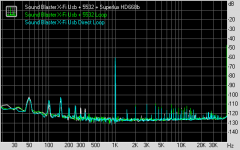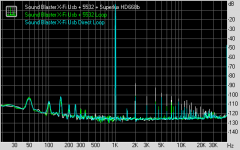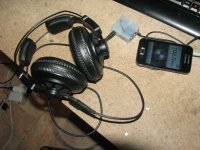You must have been thinking of the "Headbanger" amp then, which does in fact make use of said LM386.
Your '5532 does seem to break a bit of a sweat at 32 ohms there, but not any more so than, say, a Clip+ output. The unloaded case does not look as clean as I'd expect though, even accounting for the ground loop in the measurement setup. You may want to look at baseline performance without the amplifier in between; adding a ~10R isolation resistor may also be worth a shot.
Your '5532 does seem to break a bit of a sweat at 32 ohms there, but not any more so than, say, a Clip+ output. The unloaded case does not look as clean as I'd expect though, even accounting for the ground loop in the measurement setup. You may want to look at baseline performance without the amplifier in between; adding a ~10R isolation resistor may also be worth a shot.
You must have been thinking of the "Headbanger" amp then, which does in fact make use of said LM386.
Your '5532 does seem to break a bit of a sweat at 32 ohms there, but not any more so than, say, a Clip+ output. The unloaded case does not look as clean as I'd expect though, even accounting for the ground loop in the measurement setup. You may want to look at baseline performance without the amplifier in between; adding a ~10R isolation resistor may also be worth a shot.
huh i used cheap rca cables sorry. its incredible how much you can see from this graphs , i wonder if line in was not 3.5mm stereo would this card measure better than this way.
Attachments
what concerns me is fact that this produces lot better sound than my pc soundcard output , and lot better channel separation as each 5532 sits on its own channel , no audible noise on headphones at all . should i remove the 100 ohms series resistor will that make things worse ?
my question is why this sounds good and why there is no thread for this matter
1. You can reduce the 100 ohm resistor, or remove it entirely - though its safer to keep some minimum value, say 10 ohms, to protect against shorts. How it will affect the perceived sound quality depends on a lot of things and cannot be predicted a priori.
2. There is no thread for "why this sounds good" because there is nothing to discuss really. You find your NE5532-based unity gain headphone buffer sounds better than your sound card headphone amp. This is neither surprising nor interesting, except, I suppose, as a nice demonstration of the rock-solid unity-gain stability of the 5532 op amp.
I have just used bog standard op-amps with a buffer resistor to drive headphones with good results.
I used one on a dual record deck mobile disco where I had one deck being monitored in one ear and the other deck in the other ear. Worked a treat even with the disco on full volume I could hear the channels for cueing.
I used one on a dual record deck mobile disco where I had one deck being monitored in one ear and the other deck in the other ear. Worked a treat even with the disco on full volume I could hear the channels for cueing.
I love that site. Now that's a headphone amplifier! None of this "let's try to drive headphones with op amps designed for line-level audio" nonsense.
(That's not a knock, Nigel, as you know they work just fine. It's just that if you want to take things to the next level you have to jettison this approach entirely in my opinion.)
Last edited:
1. You can reduce the 100 ohm resistor, or remove it entirely - though its safer to keep some minimum value, say 10 ohms, to protect against shorts. How it will affect the perceived sound quality depends on a lot of things and cannot be predicted a priori.
2. There is no thread for "why this sounds good" because there is nothing to discuss really. You find your NE5532-based unity gain headphone buffer sounds better than your sound card headphone amp. This is neither surprising nor interesting, except, I suppose, as a nice demonstration of the rock-solid unity-gain stability of the 5532 op amp.
switch is in place of 100 ohm resistor .
it is both suprising and interesting for me becouse i didnt knew you can use simple opamp as headphone driver,and that low current out can give good output into headphones with 56ohms.
I love that site. Now that's a headphone amplifier! None of this "let's try to drive headphones with op amps designed for line-level audio" nonsense.
(That's not a knock, Nigel, as you know they work just fine. It's just that if you want to take things to the next level you have to jettison this approach entirely in my opinion.)
That is a very fine headphone amplifier.
I wish I was literate in Japanese (and Chinese too).🙁 All the good engineering stuff is either in Japanese or Chinese now.
I have Japanese clients, and they are very good to me. But I feel kind of stupid around them. They have kept me around for a couple of years though; nobody else has lasted more than a few weeks.
It's not so much a matter of connectors but rather of balanced / unbalanced. Any measurement setup of type PC --> soundcard out --> DUT --> soundcard in --> PC includes a first-rate ground loop.huh i used cheap rca cables sorry. its incredible how much you can see from this graphs , i wonder if line in was not 3.5mm stereo would this card measure better than this way.
Which is why Pete Millett (of Millett Hybrid amplifier fame) designed a sorta-balanced measurement frontend years ago.
Yes, you can read a lot out of these measurements if you've been staring at them for a few years. 😀 In this case the "fuzz" on the noise floor and mains-related harmonics are a dead giveaway for a ground loop.
As for the effects of output loading, you can see this in the harmonics in the THD and SMPTE intermod tests.
The only thing that RMAA has no idea of is absolute levels. You have to keep track of these yourself with the multimeter.
(BTW, I think the "normalize levels" option in RMAA is broken and has been so for years. It still starts giving weird results if levels are too low. Turn on saving of recorded waveforms, use Audacity or whatnot to recover level digitally, and lo and behold, results are OK again. A number of tests also are sensitive to DAC vs. ADC clock deviation - like swept IMD, swept THD even more so. Much fun if you want to measure a portable player with about a 0.1% deviation.)
With a bit of a PSRR problem in the virtual ground. Nothing that a lil' electrolytic in parallel with R2 couldn't solve, mind you.That is a very fine headphone amplifier.
Typical 32 Ohm moving coil headphones have a rising impedance above about 5 kHz, giving boosted high treble from 100 Ohm sources.
I have never seen measurements of high impedance and exotic planar types. These may well be dropping in impedance at the top end
I have never seen measurements of high impedance and exotic planar types. These may well be dropping in impedance at the top end
My advise to the OP:
1) Your voltage regulators. 78xx are not very good performing chips, and capacitance isn't everything. A lot of non-electrical engineers believe that the more capacitance the better, with no end, and in reality the chip you choose and it's application are more important. You want a Vreg with much lower noise, and better transient reponse. Try using the LT1963 for example. Follow the datasheet.
2) Your opamp. The 5534/5532 are okay opamps to my taste, I personally find them to not be clear enough, and have found that switching to LME49990 or OPA827 made a HUGE difference for the better, it shocked me how much better.
1) Your voltage regulators. 78xx are not very good performing chips, and capacitance isn't everything. A lot of non-electrical engineers believe that the more capacitance the better, with no end, and in reality the chip you choose and it's application are more important. You want a Vreg with much lower noise, and better transient reponse. Try using the LT1963 for example. Follow the datasheet.
2) Your opamp. The 5534/5532 are okay opamps to my taste, I personally find them to not be clear enough, and have found that switching to LME49990 or OPA827 made a HUGE difference for the better, it shocked me how much better.
1)would have used lt1083 but i got fake ones from ebay(10 pieces 10 bucks 😀). 78xx and 79xx with 4times 4700uf(25v capacitors so they are small and i have stash) transformer is 10-15 VA,maybe more. this psu powers few more things not only this headphone amp.
2)1V/us slew rate opamps in other audio things i use,but they sound good . that both opamps you recomended are 28V/us and 22V/us , which i cannont confortably use , and dont know why should i use them ,i dont know why you need more mhz bandwidth for analog audio?
2)1V/us slew rate opamps in other audio things i use,but they sound good . that both opamps you recomended are 28V/us and 22V/us , which i cannont confortably use , and dont know why should i use them ,i dont know why you need more mhz bandwidth for analog audio?
1)would have used lt1083 but i got fake ones from ebay(10 pieces 10 bucks 😀). 78xx and 79xx with 4times 4700uf(25v capacitors so they are small and i have stash) transformer is 10-15 VA,maybe more. this psu powers few more things not only this headphone amp.
2)1V/us slew rate opamps in other audio things i use,but they sound good . that both opamps you recomended are 28V/us and 22V/us , which i cannont confortably use , and dont know why should i use them ,i dont know why you need more mhz bandwidth for analog audio?
1) as long as you stimulate the circuit before deciding it is worth soldering. The fake ones you got on eBay, ok maybe y use a scope. I don't know how much your time is worth, but if you're going to take the time to engineer and assemble and test a circuit, get some genuine components.
2) you're right, 20+MHz is unnecessary. As an electrical engineer i cannot give you a confident reason why one opamp sounds better than the next. But, if we are going to take the time to discuss this, please go and try the opamps i mentioned in a circuit. I absolutely promise it will make an audible difference. I do not promise whether that will be for the better or for the worse, but try it.
The dual version of LME49710 is LME49720. It looks like OPA827 doesn't come in a dual package. They don't come in a quad package. Very-high performance opamps often don't come in quad packages (separate filter capacitors for each opamp in single packages reduces crosstalk and PSRR).
Let me know what you think. To my ear, the LME48710 has fantastic clarity, almost to a fault. Less-than-perfect recordings sound kind of offensive. Like a news reporter with a pimple on HDTV. But good recordings sound that much better. The OPA827, to me, has similar clarity, maybe less blatant, but the bass sounds bigger, which is ejoyable. Not sure which I like better, both are good. The 48710 runs cooler. The NE5534, to me, personally, was muffled, with and without the 22p compensation capacitor. Outputs of all three opamps on the oscilloscope were nearly perfect, noise was marginally lowest on the LME49710.
Let me know what you think. To my ear, the LME48710 has fantastic clarity, almost to a fault. Less-than-perfect recordings sound kind of offensive. Like a news reporter with a pimple on HDTV. But good recordings sound that much better. The OPA827, to me, has similar clarity, maybe less blatant, but the bass sounds bigger, which is ejoyable. Not sure which I like better, both are good. The 48710 runs cooler. The NE5534, to me, personally, was muffled, with and without the 22p compensation capacitor. Outputs of all three opamps on the oscilloscope were nearly perfect, noise was marginally lowest on the LME49710.
I you trust me not to pirate your design, which I promise, I would offer to edit EAGLE files if you send me a .SCH and .BRD file-- I use EAGLE all the time and am very good with it.
Quad opamps are a bit of a niche solution for when board space is at a premium. There have hardly been any new types since the mid-'80s or so, I guess people found them too inflexible (plus good supply bypassing is not that easy). Output stages are usually weak.The dual version of LME49710 is LME49720. It looks like OPA827 doesn't come in a dual package. They don't come in a quad package. Very-high performance opamps often don't come in quad packages (separate filter capacitors for each opamp in single packages reduces crosstalk and PSRR).
As for opamps that are only available as singles, I believe it's mostly an issue of power dissipation. Higher-performance types tend to have an idle current draw of 6-8 mA per amp, and you just can't put two of those into one DIP-8 package at +/-18-22 V without them getting uncomfortably warm even in idle.
Notable single-only types include e.g. LF356, OPA602, OPA627, a bunch of LT types, AD797, AD4898-1, MAX9632. (Apparently a dual version of the OPA827 was available or planned at one point, as you can still find old datasheets mentioned an OPA2827.)
There are a few quad-only types as well, such as OP470/471.
The dual version of LME49710 is LME49720. It looks like OPA827 doesn't come in a dual package. They don't come in a quad package. Very-high performance opamps often don't come in quad packages (separate filter capacitors for each opamp in single packages reduces crosstalk and PSRR).
Let me know what you think. To my ear, the LME48710 has fantastic clarity, almost to a fault. Less-than-perfect recordings sound kind of offensive. Like a news reporter with a pimple on HDTV. But good recordings sound that much better. The OPA827, to me, has similar clarity, maybe less blatant, but the bass sounds bigger, which is ejoyable. Not sure which I like better, both are good. The 48710 runs cooler. The NE5534, to me, personally, was muffled, with and without the 22p compensation capacitor. Outputs of all three opamps on the oscilloscope were nearly perfect, noise was marginally lowest on the LME49710.
i use quad opamps in active crossover so crosstalk is not issue ,and i use separate chips for each channel , sort of dual mono. i never compared different opamp internal schematics and wrongly assumed that all are same schematics. now i see where is difference
I you trust me not to pirate your design, which I promise, I would offer to edit EAGLE files if you send me a .SCH and .BRD file-- I use EAGLE all the time and am very good with it.
there is no eagle files as i put that schematic from part of finished unit, sort of gathered few schematics in one box thing, and its not design of any kind its all on prototype boards but its working well for testing purposes. (dont have job so thats why testing, too much spare time)
Quad opamps are a bit of a niche solution for when board space is at a premium. There have hardly been any new types since the mid-'80s or so, I guess people found them too inflexible (plus good supply bypassing is not that easy). Output stages are usually weak.
As for opamps that are only available as singles, I believe it's mostly an issue of power dissipation. Higher-performance types tend to have an idle current draw of 6-8 mA per amp, and you just can't put two of those into one DIP-8 package at +/-18-22 V without them getting uncomfortably warm even in idle.
Notable single-only types include e.g. LF356, OPA602, OPA627, a bunch of LT types, AD797, AD4898-1, MAX9632. (Apparently a dual version of the OPA827 was available or planned at one point, as you can still find old datasheets mentioned an OPA2827.)
There are a few quad-only types as well, such as OP470/471.
interesting but i run 5532 from +-15v and they are not hot. neither those quad ls404 are hot.
will buy those op470 from ebay and some other dual opamps to try in circuit how is now, to see how it works and measures afterwards. if there is lot of improvment i could make small pcb sort of adapter with more supply capacitors and 4 single opamps(LME49710 comes in metal package ? thats serious stuff 😱) in place of single quad opamp,to connect on dip 14 port. to get more improovment .
and post results and measurments from both headphone and other measurments here. ofcourse i need to wait almost full month for chips to arrive to post results here.
edit:LME49740 Pro Audio Quad Low Noise OpAmp PSRR 120 DIP 14 | eBay
lol there is quad version of lme49710 called LME49740 ,nice naming scheme 🙂 , i will go with this chips and LME49720 in place where i need duals , and will measure how its now with 5532,404 , measure with lme-s and put here compare results.
Last edited:
- Status
- Not open for further replies.
- Home
- Amplifiers
- Headphone Systems
- single NE5532P headphone amp ?!







